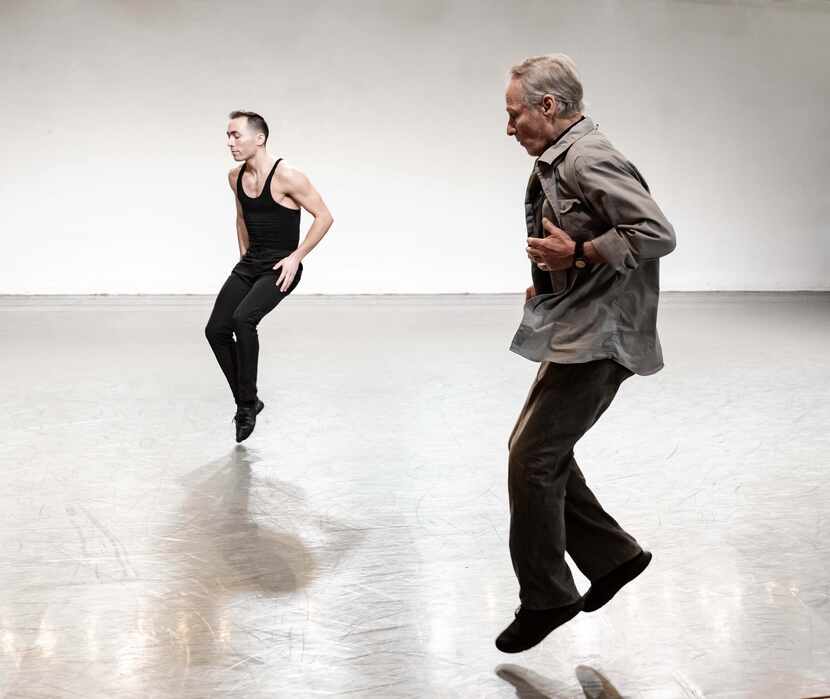Lar Lubovitch is one of the last remaining choreographers from a generation trained by modern dance pioneers like Martha Graham and José Limón. The 78-year-old Chicago native intended to become a painter until an encounter in gymnastics class with a professor who needed men to lift her female dance students led him to his true calling.
“I was very lucky, just by chance,” Lubovitch says in an interview at the Dallas Design District studios of Bruce Wood Dance, where he was coaching the company as it rehearsed his Elemental Brubeck, to be performed at its upcoming fall concerts. “I immediately ran toward it.”
Decades later, Wood became a member of Lubovitch’s New York-based group. Two weeks before the start of an important season at City Center, the Fort Worth native was brought in as an emergency replacement when Doug Varone, whose company coincidentally appeared in Dallas last month, suffered an injury and had to drop out.
“He was quite a big mover, not unlike Doug — broad and in the ground,” Lubovitch recalls. “He learned this massive dance, almost in a day, because he was a fast study. He rescued that dance and did marvelously. From that time on, he was in the company.”

Wood, who died in 2014, often cited Lubovitch as an influence on his work. They both came from a specifically American tradition of musicality and outward emotionalism that had started with Russian immigrant George Balanchine’s innovations in ballet and continued with second- and third-generation modern choreographers like Paul Taylor and Twyla Tharp. The latter also was an influence on Wood, who danced in her company before joining Lubovitch.
“He never ‘marked’ in the studio,” Lubovitch says of Wood, referring to the practice of under-dancing physically in order to study a piece mentally. “It’s a skill actually. But some dancers never under-do. They’re always going full-out and Bruce was one of the full-out people. He had a lot of passion.”
They became friends. “On the personal side, Bruce was a lot of fun,” Lubovitch says. “He was very funny outside of work, a very entertaining person to spend time with. On tour, we did that quite a lot. He was one of the people I hung out with.”

Devastated by the AIDS crisis, Wood returned to North Texas in the late ‘80s and soon started his own company. The work that he learned so quickly, A Brahms Symphony, had been a breakthrough for Lubovitch in 1985. Wood also played a major role in the 1986 sequel-of-sorts, Concerto Six Twenty-Two, set to Mozart.
After a period of introspective experimentation, Lubovitch had returned to his original style of making dances on his own body rather than trying to draw it out of his company members.
“Just tell the truth and say who you are,” he explains. “I decided consciously that all of my work was about dance itself, which is a deep and meaningful subject. It was a big, passionate dance about dancing with big, curvaceous, virtuosic movement. It was a major statement: ‘Pass or fail, this is me.’ "
Though Lubovitch took his first three dance classes ever from Graham, Limón and Alvin Ailey at the American Dance Festival over a matter of hours, he says it was the British ballet choreographer Antony Tudor he went on to emulate. Along with Graham and Limón, Tudor was a teacher at Juilliard, where Lubovitch transferred following his freshman year at the University of Iowa.

“He was the first choreographer to bring psychological characters into ballet rather than birds and fantasy people,” Lubovitch says. “But it was his relationship to music that was most influential on me, his way of pictorializing music rather than imitating its beat and structure, actually behaving like the music, which he was very good at.”
This approach connected to Lubovitch’s background as a painter and as a lover of Chicago’s monumental architecture growing up. He sees music as shapes that morph, he says. “I realize I’ve been painting in space all this time, and the dancers have been the paint, filling the entire canvas.”
He’s a populist too — “I don’t try not to be understood” — which has led to gigs choreographing Broadway musicals like Into the Woods and ice dancing. Performers have reported that his choreography feels good on their bodies.
“It’s more that I would never turn down a job. I went where I was asked,” Lubovitch says of his eclectic career. “John Curry, who had been an Olympic gold medalist, had seen my work and thought it looked like skating. I was a very good dancer and consequently I know what feels right next. If I do a certain step or gesture, I’m looking for the next inevitable thing to happen.”

With Elemental Brubeck, part of Bruce Wood Dance’s Nov. 19-21 program at Moody Performance Hall, Lubovitch was commissioned by the San Francisco Ballet to create a jazz piece to premiere at a festival in Paris. In his search for music, he found Dave Brubeck’s only orchestral work, the 16-minute “Elementals.”
Looking to round out the score, he landed on two shorter, related numbers, “Iberia” and “Theme from Elementals,” to precede it. He describes Elemental Brubeck as “an upside-down pyramid,” which opens with a solo for a dancer clad in a red bodysuit, then moves into a duet, followed by choreography for nine. “I can’t tell you why I saw a red man dancing,” he says, “but that’s what I saw from the get-go.”

At a recent run-through, Wood company member Cole Vernon high-stepped, stretched his limbs into taut curves and took leaping turns looking not unlike a song-and-dance man. Later, the rest of the company articulated Lubovitch’s sunny exuberance, complete with sensual hip rotations and jazz hands. Lubovitch drew from both social-dance idioms of the 1950s and movie musicals of the jazz period.
“This piece in particular is an anthropological dig. I’ve collected as much American popular dance movement as I knew from my own time as a teenager. Midcentury modern, really, is what I would call it,” he says. “Brubeck is so quintessentially American. His is a moment in jazz that is representative of a particular period — the last innocence.”
Details
Nov. 19-20 at 8 p.m. and Nov. 21 at 2 p.m. at Moody Performance Hall, 2520 Flora St. $25-$100. brucewooddance.org.






